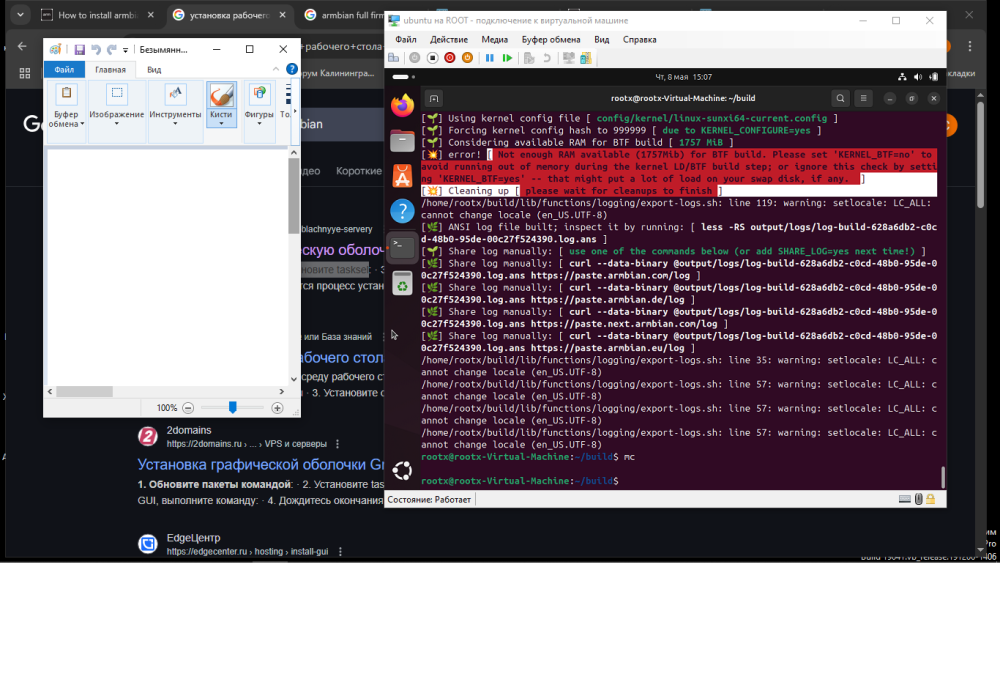All Activity
- Past hour
-
I figured out the audio, the problem was in the hdim cable. did not solve the problem with usb wifi, usb MT7601U Wireless Adapter. how to make it work?
- Today
-
Good afternoon, I have just started studying the use of embedded arm linux for single-board computers. I'm asking for help from experienced developers. I have an orange pi lite. I uploaded a prebuild minimal armbian image to the microsd card: Armbian_community_25.5.0-trunk.444_Orangepilite_bookworm_current_6.12.23_minimal.img.xz .After that, I installed mate desktop environment according to these instructions: https://forum.armbian.com/topic/28786-install-mate-desktop-to-minimal-image-blues/. The problem is that the processor heats up very much under load (I registered a temperature of 95 degrees celsius using armbianmonitor) and periodically turns off due to overheating. Please tell me if it is possible to solve the overheating problem by configuring linux (For example, limit the maximum processor frequency or lower some processor voltage) and if so, how and what needs to be configured?
-
Hi all, I'm a newbie The two boxes have similar hardware (RK3566 + Mali-G52-2EE + 8GB ram), and I've searched the forums and seen both have been experimented with Armbian. But I'm still confused about the bottom line: on which of the two Armbian is better supported or easier to run? That'll be the main deciding factor for me, but of course I'll be interested in any other comment or general advice. TIA!
-

UART won't connect no matter what I do
devmichelcastilho replied to devmichelcastilho's topic in Beginners
Still no clue what's happening... -
I don't know how to quote messages. @RaptorSDS I've "broken" the box a few times, but I fix it using rkdeveloptool and the maskrom pin on the board. My problem is that I can't use the eMMC correctly, it crashes every time I try to update the box. How do I get the serial log? I have time to help with this R29 board if you need it Now I intend to run Armbian on the SDCARD and use the eMMC as a swapfile and storage for cache and temporary files, is that possible?
-
then there is no more option, all that's left is to accept it
-
https://github.com/armbian/build/blob/9ff15f78966871bd737f0c8cbd23ee9fdb767b8d/lib/functions/host/prepare-host.sh#L48-L58 setting locale seem to fail. For the BTF thing either give the vm more memory (>8G), disable or enforce it as mentioned in the image and risk getting OOM killed.
-
-
I always liked the Marvell ARM SoCs because of their many high-speed I/O, but never bought one as the main CPU(s) were always behind w.r.t. raw computing performance, compared to RPi4 BCM2711 or Intel J1900. Ebon Upton of RPL once stated they won't do SATA. Instead they made an own I/O chip and some own ISP silicon design for the RPi5. It is because the focus on digital signage, so computing devices with screens and cameras. For many home-users it means the struggle goes on. I only use my RPi4 with Samsung SSD for fast local I/O (VMs etc), but what a trouble with that whole VIA PCIe-USB3 chip design (you extra need external power in the end). And look at how many people still want to build a NAS with a Pi; So BCM271x-PCIe<=>PCIe_USB3chip<=cable=>USB3_SATAchip<=cable=>HDD(s)/SSD. Or some 'HAT' via yet another proprietary extra flatcable. And then not to forget the powering of such a setup, need 12V, RPi can only accept 5V. I think worlds big IT companies aim for cloud, central storage, your data, your privacy, so principles and methods to store your own data locally at home seem like a relative niche. Not that non-tech people don't know what NAS and backup etc is, but automatic cloud for laptops and smartphone is so easy. Then the other issue is that 4 or 6 or even 10 or 12 SATA ports mostly imply many 3.5inch HDD which need then 100W or so, so the 'low-power ARM' is irrelevant. And people seem to want RAID, many still think that is also good backup. What I also noticed as problem with older ARM SoCs it that for example the Marvell 88F6828 in Helios4 is 32-bit (dual Cortex-A9). Modern filesystems are more tailored for 64-bit native. For example, Btrfs does not support >8TiB in 32-bit, and because of its CoW fundamentals, it can also hit that limit with <8TiB after many years of usage (or lots of 'balancing'). So you want a 64-bit CPU/OS. I have a BananaPi M1 still, also same as Helios4 2x Cortex-A9, but only 1 SATA2 connector. I still like that board, it runs Armbian 6.12.x now and I use it to export raw /dev/sda (8TB Seagate SMR) via nbd-server as Linux block device. That works fine with 32-bit, the limit is mostly random I/O speed due to SMR and being a HDD. If I do LVM, LUKS, Btrfs (Zstd compression) remote on top of nbd-client on a NanoPi R6C RK3588s, it works without noticing the Gbit ethernet in between. If I replace the BananaPi M1 with a Radxa ROCK 3A (on-chip SATA), same behavior more or less, although It can also run the whole 'NAS' stack on its own RK3568. Only disadvantage is then that on-the-fly Zstd compression is a bottleneck. So that made me order a ROCK 5B (RK3588), that has comparable I/O connectors (M.2 M-key for NVMe, M.2 E-key for a SATA passthough connector). I also ordered a ASM1166 M.2 M-key, so I can have the same functionality as old power hungry Intel PC with 6-SATA for tests/fallback. Note that for my main 24/7 NAS (the ROCK 3A system now) I keep a limit of 8TB, that means I don't buy new bigger HDD and only 1 is enough. Caching is done with LVMcache on the NVMe. If HDD is not spinning, it is about 4.5 Watt.
-
@Nick A Thanks a lot, this helps me as well
-
Probably topic name was changed, because originally my case is that bootloader doesn't even read dtb or extlinux.conf, it says no partition table on mmc 1. My box has thgbmbg7d2kbail. If booted from sd or usb it can access mmc without a problem.
-
The only way, which is really discouraged and discontinued, is to use a build with legacy kernel. On mainline kernel, the only driver supported is for ssv6051p, but it does not work for ssv6256p. There could be several reasons the eMMC is not detected. One of the reason is obviously it is the broken, even though the DDR part is still working. More often the board has some circuitry or the chip has some configuration that need to be tuned properly in software to work. Tv boxes have plenty and plenty of different configurations that is impossibile to cover all the compatibility issues that may arise. If the flash part of the eMCP is really broken, if you plug an sdcard with Armbian on it, the stock Android should not boot (obvious if the internal flash is broken) and Armbian should boot instead. About the MSN8800D, it seems to be a clone of AIC8800D chip, of which a driver is circulating and should already be integrated in armbian, but not yet enabled for rk322x.
-
@Heisath Nice to have you back. I know everyone is busy ... I think speed of this has been brought down in past year and most of changes were on the "must be done" list. Changes generate stress, regardless of their intention. It is getting more and more troublesome - big complexity vs. new devices keep coming out light-speed vs. limited resources for maintaining. We have little to fight this Freshly build image from your patch - doesn't work for me - what I am missing here?
-

Stuck on jammy, can't upgrade to noble
laibsch replied to Domas's topic in Software, Applications, Userspace
Hello @Domas, are you still trying to achieve this? You are obviously stuck in the middle now, in the twilight zone. I am fairly sure, you can still recover from this. We should first understand better ; Can you give me the output of "aptitude search '~o'" and "apt-cache policy | grep http | awk '{print $2" "$3}' | sort -u"? The way I read what is happening to you is that do-release-upgrade is trying to upgrade ports.ubuntu.com entries, fails, tries to fall back to archive.ubuntu.com but fails with that, too, because there are no armhf packages published, there. Not sure, if that qualifies as a bug in do-release-upgrade. Probably not. PS: Apart from the upgrade issue, you also seem to have an issue with filesystem corruption (lines 608 and 637 to 639 of https://paste.armbian.com/oletimumob). The ability to detect and fix these kind of issues with a live-mounted FS is one of the many reasons I switched to btrfs from ext4 a long time ago. -
Please read first page , its very very hard to brick the board normaly insert sd-card and flash another image and you good to go please provide serial log if possible , else we cannot see where th problem occur
-
@Nick A It works perfectly now. Thanks a ton!
-
@Nick A It works perfectly now. Thanks a ton!
-
@Nick A It works perfectly now. Thanks a ton
-
Thank you for reporting back. Glad you got it solved.
-

armbian-config --cmd GIT001 not installing git
laibsch replied to orlando mendez's topic in Software, Applications, Userspace
This. Just use the tools that were intended for software installation. -

Will I gain a lot by switching to Wayland?
laibsch replied to robertoj's topic in Software, Applications, Userspace
I suggest you simply try. What is holding you back? -

can't find debian package tags
laibsch replied to Jacob Burckhardt's topic in Software, Applications, Userspace
Thank you for your question, @Jacob Burckhardt I do not use tags and FWIW, I do not see them on my main laptop, running Ubuntu Noble, either. Is this a Debian thing? Is your Armbian user space Debian? -
Thank you for coming back and sharing your "solution". It is always good to hear when things work out in the end, no matter the reason.








